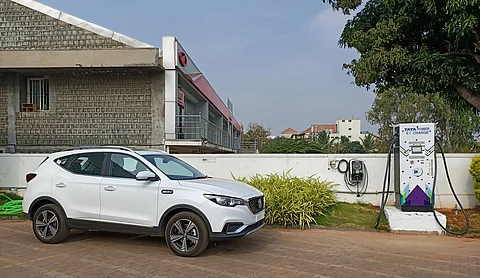

NITI Aayog's report outlines a strategic plan to accelerate India's electric vehicle (EV) adoption, aiming to reduce reliance on imported fuels and cut emissions.
Despite progress, India lags behind its 2030 target.
The report calls for enhanced incentives, mandates, and improved infrastructure to overcome challenges and boost EV penetration, emphasizing the need for stringent regulations and coordinated efforts.
NITI Aayog, the policy think tank of the Government of India, has released a report that lays out a blueprint to fast-track electric vehicle (EV) adoption in India and says transitioning to electric EVs will help the country reduce dependence on imported petroleum fuels while reducing pollution and greenhouse gas emissions.
The report, titled Unlocking a $200 Billion Opportunity: Electric Vehicles in India, states that as of 2024, India has attained only about 7.6 per cent of the sales of EVs, which is far behind the target of 30 per cent by 2030. India’s EV penetration has picked up from about one-fifth of the global penetration in 2020 to over two-fifths in 2024, but the increasing trend has been relatively slow.
While India is a leader in the electric three-wheeler segment and has done fairly well in the two-wheeler and bus segments, the penetration of e-cars and e-trucks have been slow. In comparison, China is the leader in all categories, except three-wheelers.
The report highlights several challenges that hinder the transition. These include challenges of financing vehicles, especially electric buses and electric trucks; inadequacy of charging facilities on one hand and low utilisation of existing public charging facilities on the other; and lack of adequate awareness regarding EV performance among public and private stakeholders. The report also highlights inadequate data and regulatory gaps as a challenge that hinder evidence-based decision making. For instance, it states, VAHAN portal, which offers information related to vehicles and is maintained by the Union Ministry of Road Transport and Highways, does not accurately capture data on different categories of electric vehicles, making policy design, subsidy targeting, and progress monitoring difficult. Similarly, the absence of unique battery identity (IDs) weakens tracking, resale and recycling ecosystems, hindering battery lifecycle transparency and market trust.
The report, which NITI Aayog claims to have prepared following consultations with vehicle manufacturers, charging equipment and battery manufacturers, charge-point operators and electricity distribution companies, and financial institutions, thus calls for a slew of measures to give a stronger push to the EV transition.
So far, the focus has largely been on providing incentives, both on the supply side and the demand side, to encourage a shift to EVs. Thus, under the FAME—Faster Adoption and Manufacturing of (Hybrid &) Electric Vehicles—programme subsidies are provided for the purchase of vehicles and setting up charging infrastructure. Original equipment manufacturer (OEMs) also receives benefits under the ongoing Production Linked Incentive (PLI) scheme. While over Rs 40,000 crore have been spent by way of incentives over the last 10 years, it has only reached a level where 7.6 per cent of annual vehicle sales are electric. It is evident that continuation of incentives alone may not help reach the target of 30 per cent EV sales in the next five years, states the report, which recommends introducing some gentle mandates and disincentives which will help signal the required direction more firmly.
While measures related to incentives include vehicle purchase subsidies, reduced registration fees for EVs, lower GST on EVs, and reduced electricity charges, the mandates recommended by the report include enforcing stringent vehicle emission standard, ensuring that certain share of the fleet to be zero-emission vehicles, higher registration fee internal combustion engine (ICE) vehicles and higher taxes on ICE fuels.
As immediate next steps, the NITI Aayog report suggests developing a clear policy, with targets and timelines, for transitioning to electric mobility; and a clear programme of increasingly stringent regulations that mandate the transition to EV within specified time frames. It also suggests designing new programmes to saturate five cities with 100 per cent e-buses, e-paratransit and e-freight vehicles. Designing and operationalising a blended fund would help bring down the cost of capital for e-trucks and e-buses, while setting up an inter-ministerial committee would help resolve inter-agency coordination issues speedily, the report suggests.